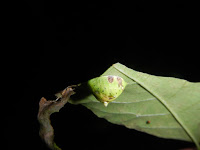Set out to do a night hike specifically looking for caterpillars, of course there was trash and I did pick up about a pack full. This post though is mainly to show you the diversity in life that can be found in eastern Pennsylvania that most don't see. Above was the first caterpillar found on this hike. A friend identified it for me as Lithacodes fasciola, a Yellow-Shouldered Slug Moth. It was a good start to the hike and my luck continued as I hiked up a portion of the Appalachian Trail.
This fuzzy little caterpillar was my next find. I believe it is Ecpantheria scribonia, a Giant Leopard Moth. I have a number of insect books and have taken several entomology courses, I don't however have a good guide for caterpillar identification. I do my best to identify species I post, though I will admit some could be wrong.
This is another caterpillar that was identified by my friend Stephen Kloiber. It is Papilio troilus, a Spicebush Swallowtail. In my posts from over the summer, I know I have put up photos of the adult butterfly. I was actually surprised it was a Spicebush Swallowtail caterpillar, because I found it on a Sassafras Tree. I have since learned that both Spicebush and Sassafras are host trees for this caterpillar. Like this species many caterpillars are very specific with what they will eat. Knowing the host plants can make finding certain species much easier.
Do you get the feeling this caterpillar is looking at you? What looks to be its eyes are just markings called eye spots. The head of the caterpillar can't be seen from this view and is right around where the little horizontal yellow line is below the eye spots. This type of patterning can help certain caterpillars deter predators from coming after them. In this case the caterpillar resembles a snake, something a bird or other predator may avoid.
This species has a different common name for both its caterpillar and adult form. It is both a Lacecapped Caterpillar and a White Streaked Prominent Moth. Many moths don't even have a common name for the adult form and somehow this species managed to get two. Oligocentria lignicolor, is the scientific name.
I am pretty sure this is Prolimacodes badia, a Skiff Moth caterpillar. This is the second time I have seen this species on a hike this year. The other I think I posted, but did not identify and it was near the Lehigh River.
This is a species I have not been able to identify as of yet. It may be extremely common, I just haven't been able to find an exact match yet.
In addition to caterpillars I found a few other insects. This is a Chinese Mantis, Tenodera sinensis, it is an introduced species. In Pennsylvania we have two other mantis species, the European and Carolina Mantis. All Mantids in this state have been introduced. None are protected by law and all can be problematic species. Some think Mantids are beneficial because they eat pest insects, the problem is they are not picky in what they eat. Mantids are voracious predators and I have come across many eating native pollinators. They have also been documented eating non-insect species including Hummingbirds.
On the trailside I heard an odd sound different from that of Katydids calling in the trees above. I search the underbrush until I spotted it. It ended up being a species of Conehead Katydid. It isn't often that I see these.
Walking Sticks! And they are mating! I have seen Walking Sticks at many locations, this was the first time I have ever seen them mating.
The last critter in this post is this porcupine. This was a Penny find and I can't take credit for spotting it.
This was the trash picked up for the night. It was a little less than a pack full. I will have to check this site again during the day later this fall. I know I didn't find and pick up everything that was up there.
You too can help with taking out the trash! If you get out hiking take a grocery bag with you, give it a second use and fill it with trash while you are out! Every bit helps. You can also help contributing to this project here: Help Fund Taking Out the Trash
Like this project? Like it on Facebook: Taking Out the Trash in Eastern PA













No comments:
Post a Comment